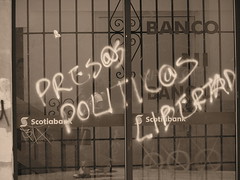Teachers' Strike: Oaxaca 2006
So I'm still learning the politics and history that provide context to the teachers' strike that took place in Oaxaca last year. The gist of it, as I understand, goes like this:
Every year Section 22 of the national teachers' union stages a strike to renegotiate pay and address issues hampering education, such as the lack of student uniforms or the downright poverty of the school system in rural areas, resulting in classes being held in cardboard and plastic shanties without appropriate materials or even sanitary facilities. It sounds like the annual teachers' strike results in modest pay raises grudgingly approved by Oaxaca's sitting governor and grudgingly accepted by the teachers, but that little else ever changes.
The L.A. Times reported that when 70,000 teachers went on strike and demonstrated in Oaxaca City's central square in May 2006, Ulises Ruiz Ortiz, governor of Oaxaca since 2004, paid little attention. Teachers camped out in the square, prepared to wait and negotiate as they do every year. Ruiz Ortiz was heavily involved in Mexico's presidential election last summer, campaigning for his party's candidate Roberto Madrazo, who failed to win a single state in the election. Ruiz Ortiz approved funds for a modest salary increase for the teachers and, it appears, expected the situation to go away. When it didn't, he retracted the funding offer and ordered teachers back to their classrooms. Teachers responded by staging massive rallies and shutting down throughways in and out of the city center. Protesters also closed the road to the airport in an attempt to disrupt tourist traffic and pressure the government to accede.
This is where the strike began to garner international attention. On June 14 Ruiz Ortiz sent police into the square with tear gas and batons to clear the demonstrators out. Striking teachers and sympathetic protesters reorganized and maintained their positions in the square, restating demands to revitalize Oaxacan schools and calling for Ruiz Ortiz's resignation. The nature of the strike evolved politically, with several opposition groups--some radical--latching onto the high profile nature of the demonstrations and raising the bombast to new levels. Radio stations were commandeered, government services disrupted and buses torched in protest.
Demonstrations continued, with protesters and the state government at an impasse. Ruiz Ortiz, whom many believed gained the governorship illegitimately, called for federal support from then-president Vicente Fox, and this call was echoed by leaders of the teachers union. Fox appeared reluctant to send federal troops to quell a local conflict in an election season and sent negotiators instead. Talks were unproductive and the city of Oaxaca languished under the conflict. The New York Times reported in late August that the strike had escalated into a political crisis and pointed out the deaths of two bystanders as evidence that neither the state nor federal governments was adequately controlling the situation.
(More to come . . . Stay tuned!)



|